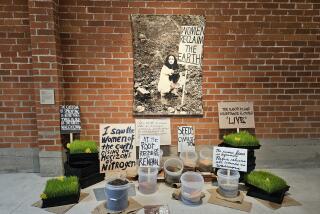Historical Focus
- Share via
Horace Bristol, the celebrated photographer, an Ojai resident for three decades until his death at 88 last summer, was an old-school photojournalist in the grand old sense of the word. He naturally shied away from the labeling of his photography as art. But give us another name for it? Bristol did bring to his work the curiosity and compassion necessary for good photojournalism. But he also had the visual grace and sense of composition of an artist.
That much is plainly evident in the cross-historical, cross-cultural sampling of Bristol’s work, now on display at the Jefferson Campus of the Brooks Institute, in Santa Barbara. The effect of the exhibit is a summarizing glimpse into a distinguished, if truncated, career that also surveys much of this dizzy century.
Bristol began his journalism career in Ventura County--in Piru and his hometown of Santa Paula--in the ‘20s, but ventured into the world as a young man. He proved to be ideally suited to the challenge of the new storytelling culture of photojournalism, as championed by such magazines as Life. Bristol’s work took him through the Depression, on the front lines of World War II’s Pacific Theater and various postwar scenes, especially in Asia, where he lived and met his second wife, Masako.
His life was not without its dark corners, including his first wife’s suicide in the ‘50s and an ensuing sense of loss, during which he contemplated destroying his negatives, his photographic life’s work, and giving up photography. In the last several years of his life, Bristol sought to get his artistic affairs in order and get his work seen. It was seen, widely, and his reputation was rescued from obscurity.
His so-called “Grapes of Wrath” series, done in collaboration with John Steinbeck before the writer went on to pen his Depression-era classic, yielded timeless images of misery and hope. “Rose of Sharon” is a classic image, in which a side-lit mother sits in a squalid work camp breast-feeding her baby, who is suckling an uncertain future.
Some of Bristol’s best work came after the social turbulence of the Depression and World War II, and is seen in the section of the show titled “Post-War Asia.” There are images with a kind of poetic grace that make them leap from their frames, such as “Smoking Car,” from 1946, a great shot with a range of tones and textures telling of urban reality gone by. “Shaving Buddhist Nun’s Head” is another stunner, marked by luminous bald orbs captured in half-light.
A hero of an earlier time in photojournalism, Bristol was about much more than gritty reality or “being on the scene.” As we gather from this modest but revealing selection of images, he was there to document reality, but his humanity and aesthetic sensitivity were ever in tow.
* “Remembrance, a Memorial Exhibit Celebrating the Life of Horace Bristol,” at Brooks Institute Jefferson Campus, 1321 Alameda Padre Sera, Santa Barbara. Hours: 8 a.m.-5 p.m., Monday-Friday; 966-3888.
*
Artistic Mexicana: In the last several years, Frida Kahlo has risen to a level of general recognition that has made her the cause celebre of female Mexican artists. But, lest we forget, there have been other important female artists from Mexico in this century.
The art of the lesser-known Mexican painter Maria Izquierdo (1902-1955), now on exhibit at the Santa Barbara Art Museum, covers similar terrain as Kahlo’s, with a vivid and rustic painterliness and a penchant for the surreal and the allegorical. Like Kahlo, Izquierdo transcended her upbringing in rural Mexico to develop a cosmopolitan attitude and a link to modernism, without losing touch with her roots. She had artistic and romantic links with Rufino Tamayo, and the French poet Antonin Artaud was drawn to her work.
This show, the first time a general survey of her art has been done in the United States, illustrates her range--from warm, rough-hewn portraits to circus sketches and allegorical vignettes. She had a distinctive approach to still-life paintings--arranging objects to create a shrine-like tableau, but tinged with the irrationality of a closet surrealist.
Her striking painting “The Indifferent Girl” depicts the artist as a young girl, in a repressive provincial setting. The subject, oddly shaped and with a blank expression, is perched uneasily in the middle of a stark room, among unexplained objects and a strange facsimile of a hot air balloon drifting casually in the sky outside. The sense of a dream is unmistakable, as is the sense of a magical, melancholy realism. And so it goes with Izquierdo’s work at large.
* “The True Poetry: The Art of Maria Izquierdo,” through Dec. 28 at the Santa Barbara Museum of Art, 1130 State St. Gallery hours: 11 a.m.-5 p.m., Tuesday, Wednesday, Friday and Saturday; 11-9 Thursday; noon-5 p.m. Sun.; 963-4364.
More to Read
The biggest entertainment stories
Get our big stories about Hollywood, film, television, music, arts, culture and more right in your inbox as soon as they publish.
You may occasionally receive promotional content from the Los Angeles Times.










